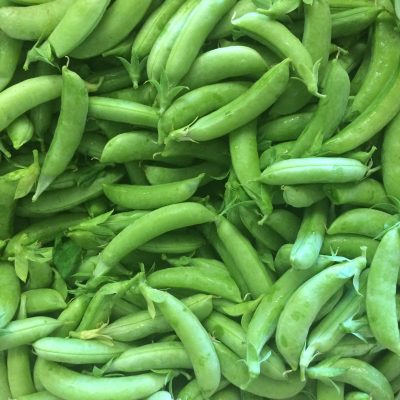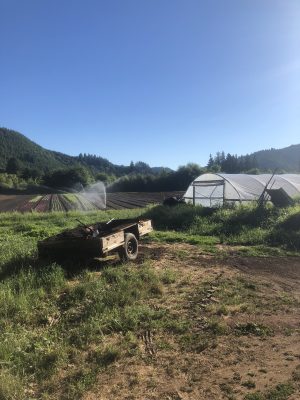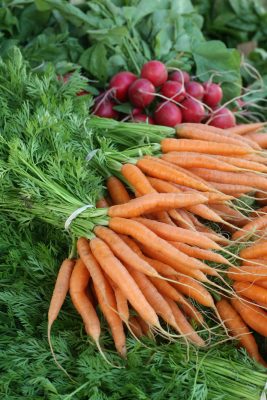Are you ready for the heat this week? Our plants are ready to soak it in. If the higher temps do happen at the end of the week, we will significant growth in our fields. Yay!!
What’s in Box #6?
Salad Mix: We are hoping to provide salad greens as often as possible. For best storage, keep greens in the fridge, in a plastic bag or other covered container with just a little bit of moisture to prevent wilting.
Beets: The first of the season. This is perfect 2-in-1 veggie. Use the sweet roots and the greens! The greens can easily be substituted in recipes that call for rainbow/Swiss chard.
Cilantro: It’s back! This delicious herb is a great topping. Dress those tacos, salads and use on fish. These leaves aren’t the greatest keepers, but they do best in a covered container or plastice bag in the fridge.
Green Onions: Parade variety. These are on a nice rotation for us which is why you are seeing them so often this season.
Carrots: A Nantes-style called Nelson. These roots are very sweet and will stay fresh longer if you remove the greens.
Garlic: This garlic is fresh since we are just pulling it out of the field this week. It is not cured for storage, so please keep in your fridge. No need to use it right away, it just has not developed the cured skin that allows it to sit on your countertop for a long time.
Sugar Snap Peas: Cascadia variety. A treat that is not around very long. Edible pods with a super sweet crunch. Can be cooked or eaten raw.
Recipes:
Beet Arborio Rice Pilaf
I first had a dish similar to this at a potluck at the zendo here on the farm and had to make sure it was included in this year’s blog. The shredded beets melt away into the Arborio rice and give the whole dish an amazing color and taste. Definitely a dish you can play around with to your own taste so have fun and enjoy! ~ Laura
Yields Serves 6
From the kitchen of cookincanuck.com – https://www.cookincanuck.com/one-pot-beet-rosemary-kale-arborio-rice-pilaf-recipe/
Ingredients
1 tsp olive oil
1/2 medium yellow onion, chopped
3/4 cups arborio rice
2 cloves garlic, minced
2 tbsp balsamic vinegar
3/4 tsp dried rosemary
1 medium beets, peeled & grated (about 1 cup)
2 kale leaves, finely chopped (about 1 cup)
2 cups vegetable broth
1/4 tsp ground pepper
6 tbsp grated Parmesan cheese
Salt, to taste
Fresh lemon juice (optional)
Directions
1. Heat the olive oil in a large saucepan set over medium heat.
2. Add the onions and cook until they are tender, about 5 minutes.
3. To the onions, add the rice, garlic, vinegar and rosemary. Stir, cooking, until the rice is coated, about 1 minute.
4. Stir in the beets, kale and vegetable broth.
5. Bring the mixture to a boil, then cover and reduce heat to medium-low.
6. Cook until almost all of the liquid is absorbed, 25 to 30 minutes.
7. Season with salt and pepper. Serve, grating 1 tablespoon Parmesan cheese over each serving.
♦ ♦ ♦ ♦ ♦ ♦ ♦

Gluten-Free Crabby Noodles with Snap Peas
Source: The Gluten-Free Asian Kitchen (Laura B. Russell)
4 servings
I’m thankful for the many Asian grocery stores that carry a wide range of gluten-free noodle options (bean, rice, sweet potato, etc.). This recipe is just one of many using one such GF noodles. The actual recipe calls for snow peas, but I’ve made it with snap peas and they worked out just fine. ~Reiden
Ingredients:
6 oz. Cellophane (mung bean) noodles (sometimes called bean threads of sai fun)
4 T vegetable oil, divided
6 green onions, white & green parts, thinly sliced
4 cloves garlic, minced
½ lb. peas, cut diagonally into ¼-inch thick strips
½ lb. real or imitation crab meat (GF imitation crab meat can be found at most Safeway stores)
½ cup bottled clam juice or chicken broth
2 T Asian fish sauce
1/3 cup chopped fresh cilantro
Soak the noodles in a bowl of hot tap water until softened, about 15 minutes (noodles are done when they can be stretched and they bounce back). Thoroughly drain the noodles in a colander & cut them into smaller lengths with scissors.
Heat 2 T oil in large frying pan or wok over medium-high heat. Add the green onions & garlic. Cook stirring occasionally for 1 minute. Add peas & cook 1 minute longer. Add remaining 2 T oil to the pan & then stir in the noodles & the crab. Toss with tongs to combine. Add clam juice & fish sauce. Simmer, turning noodles occasionally until they are tender and absorb most of the liquid, 3-5 minutes. Remove pan from heat and toss in cilantro.
♦ ♦ ♦ ♦ ♦ ♦ ♦
Sesame Salad Dressing or Veggie Dip
2 Tbl Olive Oil (Xtra Virg)
2 Tbl Sesame Oil
2 Cloves Garlic
4 Tbl Balsamic Vinegar
2 Tbl Soy Sauce
1 Tbl Ground Mustard
Juice of One Orange
1 Block Tofu
To Taste Fresh Grated Ginger
Black Pepper
Mix all ingredients in blender. Adjust sesame oil and vinegar to reflect desired results. Thin mixture with water or more olive oil depending upon usage.
Thanks to 1997 Farm Apprentice Sophie Bello (now owner of Groundwork Organics)!

 Photo taken by Taylor’s friend
Photo taken by Taylor’s friend

